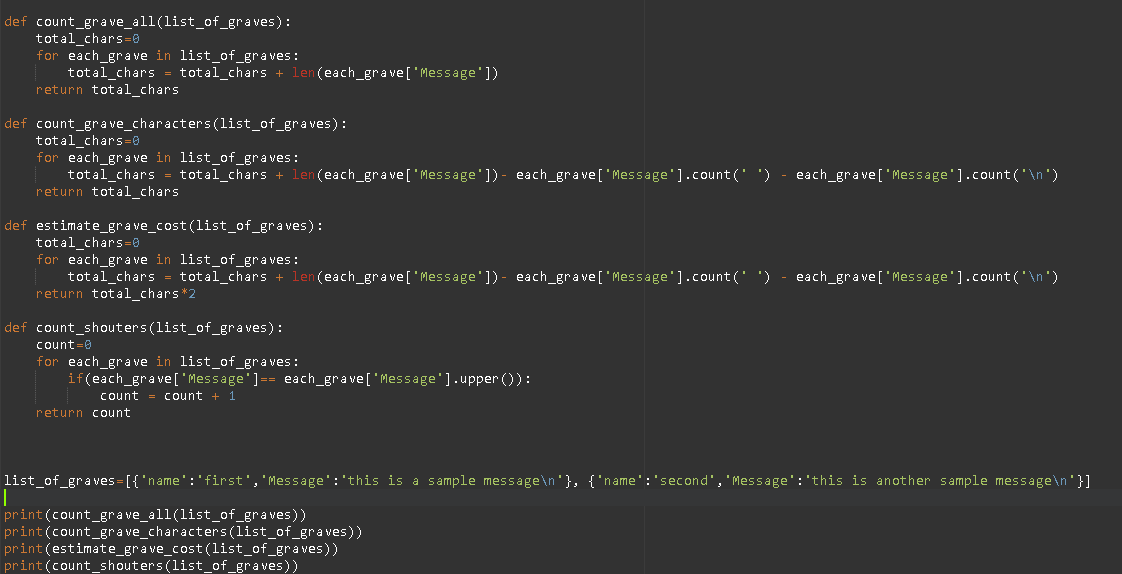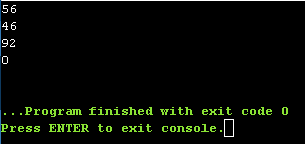Question
In: Computer Science
Python 3.7.4 ## Tombstones ''' A Grave is a dictionary with two keys: * 'Name': A...
Python 3.7.4
## Tombstones
'''
A Grave is a dictionary with two keys:
* 'Name': A string value with the grave's occupant's name
* 'Message': A string value with the grave's message
'''
Grave = {'name': str, 'Message': str}
'''
G1. Define the function `count_grave_all` that consumes a list of
graves
and produces an integer representing the number of characters
needed to
write all of the message of the grave. Include spaces and new
lines.
'''
'''
G2. Define the function `count_grave_characters` that consumes a
list of graves
and produces an integer representing the number of characters
needed to
write all of the message of the grave. Do not count spaces and new
lines.
'''
'''
G3. Define a function named `estimate_grave_cost` that consumes a
list of graves
and produces an integer representing the total estimate lettering
cost by
multiplying the number of letters on the grave (ignoring spaces and
newlines) by
the cost of writing a letter ($2).
'''
"""
G4. Define a function named `count_shouters` that consumes a list
of graves
and produces an integer representing the number of graves that had
their
messages in all capital letters. Hint: use the `.upper()`
method.
"""
Solutions
Expert Solution
Here is the code you need:

def count_grave_all(list_of_graves):
total_chars=0
for each_grave in list_of_graves:
total_chars = total_chars + len(each_grave['Message'])
return total_chars
def count_grave_characters(list_of_graves):
total_chars=0
for each_grave in list_of_graves:
total_chars = total_chars + len(each_grave['Message'])-
each_grave['Message'].count(' ') -
each_grave['Message'].count('\n')
return total_chars
def estimate_grave_cost(list_of_graves):
total_chars=0
for each_grave in list_of_graves:
total_chars = total_chars + len(each_grave['Message'])-
each_grave['Message'].count(' ') -
each_grave['Message'].count('\n')
return total_chars*2
def count_shouters(list_of_graves):
count=0
for each_grave in list_of_graves:
if(each_grave['Message']== each_grave['Message'].upper()):
count = count + 1
return count
list_of_graves=[{'name':'first','Message':'this is a sample message\n'}, {'name':'second','Message':'this is another sample message\n'}]
print(count_grave_all(list_of_graves))
print(count_grave_characters(list_of_graves))
print(estimate_grave_cost(list_of_graves))
print(count_shouters(list_of_graves))
Output:

Hope you like it!
Please provide comments if you have any doubts!
Related Solutions
how to check if there are keys with the same values in a dictionary. python 3.0...
python Create a dictionary and insert several English words as keys and the Pig Latin (or...
Use Python for this quetions: Write a python functions that use Dictionary to: 1) function name...
Write code to create a Python dictionary called class. Add two entries to the dictionary: Associate...
Weight Lifting Make a dictionary where the keys are the names of weight lifting exercises, and...
Please write in Python 3.7.4 or Higher. The Payroll Department keeps a list of employee information...
**Use Python 3.7.4 *** 1. Ask the user for the number of hours worked, salary per...
ising software pyton 3.5 Weight Lifting Make a dictionary where the keys are the names of...
####################################################################### ##################################### ###############python################# # RQ1 def merge(dict1, dict2): """Merges two Dictionaries. Returns a new dictionary that...
Python 3.7.4: The current calendar, called the Gregorian calendar, was introduced in 1582. Every year divisible...
- 1) 10000 lb/h of a 40.00% NaoH solution is crystallized through a combined evaporator-crystallizer process. The...
- STRICT DOWNVOTE IF NOT DONE FULLY, WILL REPORT ALSO IF COPY PASTED OR MODIFIED ANSWER Develop...
- The three questions are basically looking for an observation, asking the question and then giving the...
- YOU are the financial officer at an Austrian company that wants to BUY USD 1.000.000 of...
- Please read the whole program (all the way to the bottom), Thanks in advance! Develop car...
- A)Consider the following gases, all at STP: Ne, SF6, N2, CH4. Which gas is most likely...
- Coors and Anheuser-Busch (Budweiser) are competing against each other to try to capture a larger share...
 venereology answered 1 month ago
venereology answered 1 month ago